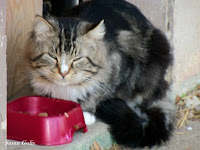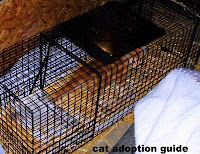Being a feral cat colony caregiver is not a volunteer service for everyone, as once you commit to the position it is lifelong responsibility. As a feral cat colony caregiver you will provide these cats with shelter, regular feedings and keeping them up to date with sterilizations and vaccinations.
Being responsible for a cat colony is a charitable service; you volunteer your time and collect donations to offset the costs for food and veterinarian care. Learn what caregivers do before you take on the responsibility of caring for feral cats.
If you were born to do this work then the feral cats
will choose you. They have a natural way of finding people that love
cats. Put out a bowl of dry food and fresh water and if their are cats in your neighborhood they will find your feeding station.
Locating Feral Cats
If
there are no cats visiting you in your yard then you will need to
look for the feral cats in your neighborhood.
Do this by searching
wooded areas that would have thickets. Some cats will take shelter
under decks, or in sewer pipes.
Many feral cats can be found by
grocery store dumpsters or hanging out in city and state parks.
Setting up Feeding Station
Select
a feeding station that is away from a busy street. Set up the
feeding station so that it is protected from adverse weather. A heavy
duty box will provide some protection. I use the plastic top to my
indoor cats litter box. I set the food and water bowl at the
entrance and then set a rock on top to keep it from blowing away.
Another way to
provide shelter for the feeding station is to set the food and water
bowls on a step that has an overhang or an awning to protect the food
in the case of rain or snow.
My feeding station is on the woods side of my yard in a safe area. I feed the cats directly outside on the step of our shed.
The kitty door is always open and food available indoors too. Over the years the
feral and woodland cats have found their way to the feeding station.
Feed the cats a high protein dry cat food. I feed my colony Purina One Smart Blend
 chicken and rice formula.
chicken and rice formula.
The cats like the taste of the crunchy kibble and I know that their diet is rich in real chicken, omega-6, antioxidants and protein.
Plan on feeding the cats twice a day, a bowl food and fresh water in the morning and at night. I feed my cats at 7 am and 6 pm. If you cannot feed your cats at the specific time ask someone to put out the food and water.
Feral cats get along however if they are hungry and no food is available they will become agitated and that is when fights occur. So feed them their meals on time. Continue to feed the cats daily. By doing this, the cats are growing dependent upon you.
Trap Neuter and Return (TNR)

TNR is an effective method for reducing feral cat populations. When the cats are dependent upon you it is time to bring out the medium size live animal traps.
You must trap the feral cats for veterinarian care. All colony cats must be tested for feline leukemia and AIDS. They also need to be vaccinated for rabies, distemper, wormed and spay or neuter. If you do not have a live animal trap you may contact your local animal control and inquire about the usage of a trap or purchase a medium size trap.
Contact your veterinarian and let them know that you are a caregiver to feral cats and that you plan on trapping feral cats for medical care and sterilization. Inquire about their procedure also contact the cat networks in your area and inquire about a coupon card to offset the costs for the feral cats spay or neuter.
My veterinarian will take the feral cats as soon as I trap them. I schedule my trapping for Monday - Friday during the day only.
If the colony is large it is best to ask other colony cat caregivers to assist you with the trapping of the cats.
It is best to trap all on in one day.
- Do not feed the cat the night before you trap.
- On the day that you set up the trap, the only food available will be inside the trap.
- Line the trap with newspaper.
- Drop Friskies whitefish canned food
 down the center, the fish will lure the cat into the trap.
down the center, the fish will lure the cat into the trap.
- Set the trap close to the feeding station.
On the days that I trap, I am able to watch the trap from my laundry room window. It is not wise to leave the trap unattended. Trapping may take up to a week.
The last kitten that I trapped took me two weeks. Be patient the trap will close. When the trap door closes, cover the entire trap with a blanket. The blanket will comfort the cat. Bring the cat inside your garage, basement or house.
Set the trap in a quiet room or take the cat directly to the veterinarian's office.
(TNR) = trap neuter and return program.
When cats return from the veterinarian office, the female will need to stay inside for medical care for 3-4 days, release the male cat to the same area in which you found him. Allow him to regroup with the colony.
Provide a Winter Cat Shelter
Provide the cat colony with a wind and waterproof shelter. A utility shed, or an over sized flat roof doghouse could be used as a shelter. Cats need two doors, one in the front and one in the back. The back door is the escape door.
 |
| Winter bedding for feral cats |
 |
| Kerosene heater keeps shelter warm overnight |
I provide shelter for the feral cats in my old shed. I selected an area in the shed that is away from the entrance. By doing this I have protected the cats from drafts and from intruders.
Many of the feral cats winter in a corrugated shipping box
 that has a thermal fleece blanket and then is topped with straw. The straw bedding does not retain moisture and thus it will keep the feral cats warm.
Another way to proved shelter is to cut an opening in a plastic storage container (the kind that has a locking lid). The opening should be on the side and is the entrance for the cat. Line the container with a fleece blanket and a thick layer of straw. The plastic container will provide a wind block and it is waterproof too.
that has a thermal fleece blanket and then is topped with straw. The straw bedding does not retain moisture and thus it will keep the feral cats warm.
Another way to proved shelter is to cut an opening in a plastic storage container (the kind that has a locking lid). The opening should be on the side and is the entrance for the cat. Line the container with a fleece blanket and a thick layer of straw. The plastic container will provide a wind block and it is waterproof too.
Tips and Warnings
- Allow no children close to the feral cats
- Never yell or be impatient with a feral cats
- Move slowly around feral cats
- Feral cats
 are terrified of humans, they will try to protect themselves if you attempt to pet or pick them up. If you are bitten by a feral cat you will need shots to prevent rabies and the cat will be euthanized.
are terrified of humans, they will try to protect themselves if you attempt to pet or pick them up. If you are bitten by a feral cat you will need shots to prevent rabies and the cat will be euthanized.
- Network for cat lovers to help you to oversee your colony.
- Rescue feral cats should they become trapped in sewers or thickets that are packed with snow.
- Raise money for feral cat medical costs by offering your trapping and relocation services. Charge a fee and then apply the fee to pay for spay, neuter, tests, vaccines or euthanize costs for the cats.
Keep a journal on all of the cats. Note their characteristics, description, and keep track of their medical care. Take a photograph of the cats and attach the photo to their profile page.
on all of the cats. Note their characteristics, description, and keep track of their medical care. Take a photograph of the cats and attach the photo to their profile page.














